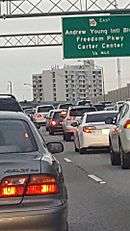Freedom Parkway
Freedom Park is one of the largest city parks in Atlanta, Georgia, United States. The park forms a cross shape with the axes crossing at the Carter Center. The park stretches from west-east from Parkway Drive, just west of Boulevard, to the intersection with the north-south BeltLine Eastside Trail, to Candler Park, and north-south from Ponce de Leon Avenue to the Inman Park/Reynoldstown MARTA station. Freedom Parkway, a four-lane limited-access road, runs through the park west-to-east from the Downtown Connector to the Carter Center, where the main road turns north towards Ponce de Leon Avenue, with a branch continuing east towards Moreland Avenue.

History

In the 1960s, the Georgia Department of Transportation began acquiring land for two east-side freeways. The north-south route would have cut north from I-20 through Virginia-Highland, creating an interchange at I-85 and continuing north as what is now SR 400. The east-west route (part of which is now Freedom Parkway) would run east from the Downtown Connector (I-75/85) to the Stone Mountain Expressway. A cloverleaf interchange for the two was to be atop the prominent hill where the neighborhood of Copenhill was demolished, and where the Jimmy Carter Library and Museum and Carter Center now stands. The east-west portion from Downtown to Copenhill and the north south portion from Copenhill north to the I-85/SR 400 interchange, was to carry the interstate number I-485.
Through purchases and eminent domain, the GDOT assembled much of the central portion of the project land, and had already demolished 500 homes when local protests and lawsuits, and Governor Jimmy Carter finally stopped the project in the 1970s.
That land sat vacant and overgrowing with kudzu for more than 20 years. Shortly after the 1990 selection of Atlanta for the 1996 Olympic Games, Mayor Maynard Jackson brokered a solution allowing the current parkway to be completed out to Ponce de Leon Avenue to the north and Moreland Avenue to the east. The strip of land further to the east, and land along the new parkway segment, was converted into a linear park with the help of PATH. The 207-acre (84-hectare) Freedom Park was officially dedicated on September 19, 2000 with ribbon cutters Jimmy Carter, then-current Governor Roy Barnes, and Mayor Bill Campbell. Since then it has hosted a number of outdoor sculpture displays and is a popular jogging, bike riding, and dog-walking park.
With the 2012 opening of the BeltLine's busy Eastside Trail, which crosses the Freedom Park Trail just west of the Carter Center, the trail became connected to the large citywide BeltLine ring of parks and trails.
Geography

The main portion of Freedom Parkway, running east from an oversized interchange with the Downtown Connector (I-75/85) and then north at the Carter Center to Ponce de Leon Avenue (US 78), is numbered and signed as SR 10. The "Freedom Parkway East" portion running around and to the east of the Carter Center is Georgia State Route 42 Connector, linking it to Moreland Avenue (US 23/SR 42, and the Fulton/DeKalb county line) just north of Little Five Points. This area is considered part of Poncey-Highland, one of the neighborhoods of Atlanta.
This portion around the Carter Center consists of two one-way streets. Eastbound, Copenhill Avenue begins as exit ramps from SR 10 northbound and southbound, then curving northward and becoming two-way as Cleburne Avenue at the northeast corner of the library property. Westbound traffic is carried along the north side on Williams Mill Road, which then becomes two-way Ralph McGill Boulevard at a surface intersection with SR 10. Freedom Parkway East continues east of North Highland Avenue as Vaud Avenue, before ending about 1,000 feet (300 m) later at Moreland.
The radio tower located immediately adjacent to the road just southwest of the Carter Center is that of WSB-TV 39 (2.1/2.2). While it appears that the "tunnel" the parkway travels through at this point is an unused overpass for a never-built road, this underpass is actually to prevent ice from falling into the roadway or onto cars during or after a winter storm. Falling ice could occur with gusty north and northwest winds from the tower itself, but one of the tower's three sets of guy wires also runs directly over the road.
Public art

Public art displayed along Freedom Parkway includes Homage to King, a 1996 sculpture by Spaniard Xavier Medina-Campeny at the corner of Boulevard, which portrays Martin Luther King, Jr. outstretching his arms, and welcomes those visiting the King Historic Site.[1][2] The Bridge, 1997, by Thornton Dial, at Ponce de Leon Avenue.[3][4] portrays congressman John Lewis' "lifelong quest for civil and human rights" and the community's "valiant efforts" to stop the construction of freeways and preserve intown neighborhoods".[5]
Future
In August 2018, the name "Freedom Parkway" is planned to be changed to the name "John Lewis Freedom Parkway", in honor of U.S. Rep. John Lewis.[6] "
References
- Atlanta Art Park, Freedom Park site Archived April 23, 2012, at the Wayback Machine
- "Homage to King", City of Atlanta public art site
- "Freedom Park Conservancy website, "The Bridge", Atlanta Art Park". Archived from the original on October 23, 2012. Retrieved February 2, 2013.
- "City of Atlanta Office of Cultural Affairs, "The Bridge"". Archived from the original on February 2, 2012. Retrieved February 2, 2013.
- Plaque at The Bridge in John Lewis Plaza in Freedom Park
- "Freedom Parkway renamed for civil rights activist John Lewis". The Atlanta Journal-Constitution. August 22, 2018. Retrieved January 26, 2019.